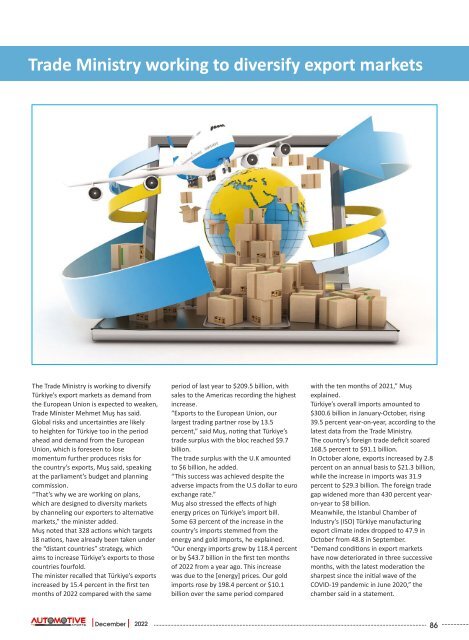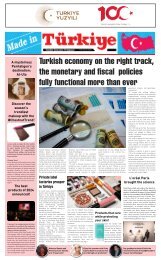Automotive Exports December 2022
Create successful ePaper yourself
Turn your PDF publications into a flip-book with our unique Google optimized e-Paper software.
Trade Ministry working to diversify export markets<br />
The Trade Ministry is working to diversify<br />
Türkiye’s export markets as demand from<br />
the European Union is expected to weaken,<br />
Trade Minister Mehmet Muş has said.<br />
Global risks and uncertainties are likely<br />
to heighten for Türkiye too in the period<br />
ahead and demand from the European<br />
Union, which is foreseen to lose<br />
momentum further produces risks for<br />
the country’s exports, Muş said, speaking<br />
at the parliament’s budget and planning<br />
commission.<br />
“That’s why we are working on plans,<br />
which are designed to diversity markets<br />
by channeling our exporters to alternative<br />
markets,” the minister added.<br />
Muş noted that 328 actions which targets<br />
18 nations, have already been taken under<br />
the “distant countries” strategy, which<br />
aims to increase Türkiye’s exports to those<br />
countries fourfold.<br />
The minister recalled that Türkiye’s exports<br />
increased by 15.4 percent in the first ten<br />
months of <strong>2022</strong> compared with the same<br />
period of last year to $209.5 billion, with<br />
sales to the Americas recording the highest<br />
increase.<br />
“<strong>Exports</strong> to the European Union, our<br />
largest trading partner rose by 13.5<br />
percent,” said Muş, noting that Türkiye’s<br />
trade surplus with the bloc reached $9.7<br />
billion.<br />
The trade surplus with the U.K amounted<br />
to $6 billion, he added.<br />
“This success was achieved despite the<br />
adverse impacts from the U.S dollar to euro<br />
exchange rate.”<br />
Muş also stressed the effects of high<br />
energy prices on Türkiye’s import bill.<br />
Some 63 percent of the increase in the<br />
country’s imports stemmed from the<br />
energy and gold imports, he explained.<br />
“Our energy imports grew by 118.4 percent<br />
or by $43.7 billion in the first ten months<br />
of <strong>2022</strong> from a year ago. This increase<br />
was due to the [energy] prices. Our gold<br />
imports rose by 198.4 percent or $10.1<br />
billion over the same period compared<br />
with the ten months of 2021,” Muş<br />
explained.<br />
Türkiye’s overall imports amounted to<br />
$300.6 billion in January-October, rising<br />
39.5 percent year-on-year, according to the<br />
latest data from the Trade Ministry.<br />
The country’s foreign trade deficit soared<br />
168.5 percent to $91.1 billion.<br />
In October alone, exports increased by 2.8<br />
percent on an annual basis to $21.3 billion,<br />
while the increase in imports was 31.9<br />
percent to $29.3 billion. The foreign trade<br />
gap widened more than 430 percent yearon-year<br />
to $8 billion.<br />
Meanwhile, the Istanbul Chamber of<br />
Industry’s (ISO) Türkiye manufacturing<br />
export climate index dropped to 47.9 in<br />
October from 48.8 in September.<br />
“Demand conditions in export markets<br />
have now deteriorated in three successive<br />
months, with the latest moderation the<br />
sharpest since the initial wave of the<br />
COVID-19 pandemic in June 2020,” the<br />
chamber said in a statement.<br />
<strong>December</strong> <strong>2022</strong> 86

















